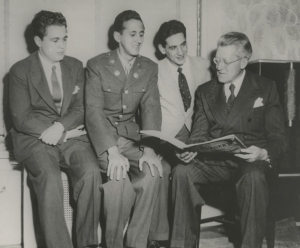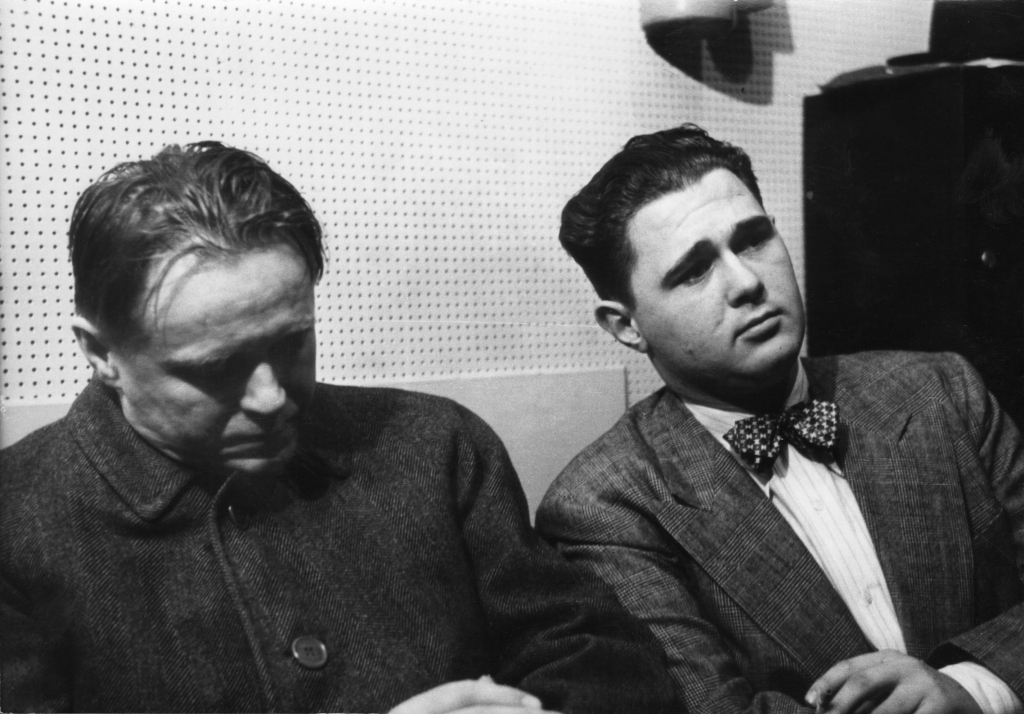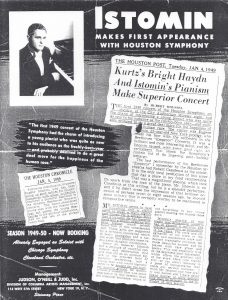Eugene Istomin’s career would not have begun so early had it not been for World War II! In September 1940, the United States re-established compulsory military service, and went to war in December 1941 after the bombing of Pearl Harbor by Japan. Shortly afterward, Hitler declared war against the United States. The country needed soldiers and all men were eligible to be drafted upon their eighteenth birthday. Artists could be drafted to the Morale Division to bring comfort and entertainment to the troops, but such an assignment was very uncertain. Byron Hardin, another Serkin student, was unlucky, despite the recommendation of his prestigious teacher, and was sent to the front lines. Istomin would be turning 18 on November 26, 1943. Serkin was concerned that such an outstanding young talent might be killed in combat, and urged him to enter two competitions which took place in October. Winning either one of them could exempt him from military service, or at least assure him of being assigned to the Morale Division. Istomin actually won both competitions – and as a result, he made his debut in Philadelphia and New York the following month. He was not yet 18.
After winning the Philadelphia Youth Contest, Istomin performed the Chopin Second Concerto with the Philadelphia Orchestra under Eugene Ormandy on November 17, 1943. He was very well received by the audience and the critics, who called him a “brilliant young artist” with an “astounding maturity”. Four days later, he was on the stage at Carnegie Hall to perform the Brahms Second Concerto with the New York Philharmonic conducted by Artur Rodzinski. This concert, which was the prize for winning the Leventritt Competition, was broadcast coast to coast to eight million listeners. In spite of terrible stage fright, the success was obvious. He was called back on stage five times and the reviews were very positive, citing “unlimited potentialities of development”. Serkin now worried about Istomin’s sudden success which might divert him from musical integrity.
The refusal of the easy way
It would have been a great temptation for Istomin to revive his Russian roots or to follow in the footsteps of Arthur Rubinstein, who had long been his idol. With his exceptional technical ease and his superb sonority, there was no doubt that Istomin could have triumphed in Chopin, Liszt, or in the showy Russian concertos. This was the path to success which nearly all young pianists attempted to follow and would have made things much easier for Istomin. The famous impresario Sol Hurok was eager to engage him and to launch his career with extensive publicity by cashing in on his Russian origin, a powerful argument at that time. By the way, the only concert of Istomin which won unanimous praise was a performance of Rachmaninoff’s Third Concerto with the Chicago Symphony in December 1944 – but he never played the concerto again. .
Serkin’s education had led to more difficult paths. Istomin’s own demands, self-esteem and taste for challenges prevented him from straying off his path. The Beethoven Fourth Concerto and the Brahms Second were works which the public and critics expected to hear only from mature pianists. Each time he played them at that stage of his career, Istomin elicited reviews like that of The New York Times in December 1944, after a performance of the Beethoven Fourth Concerto: ”An excellent performance of a great work (…), which could be understood by a youth of nineteen only if he were a Mendelssohn, a Mozart or a Schubert”.
For his first major recitals, Istomin chose programs which appeared to be less ambitious, but which were even more dangerous. He presented programs which were constructed with great musical intelligence, but which were too eclectic for the audience and especially for the critics, who became disoriented. How could one pigeonhole a pianist who was playing Beethoven and Chopin? It seemed inconceivable that the same pianist, moreover a young one, could succeed in rendering such diametrically opposed composers. What was funny, and at the same time discouraging, was that the critics never agreed on which of the two composers suited him. Some claimed that it was Chopin, others took sides with Beethoven. Moreover, when in addition, he also played Ravel and Rachmaninoff, the critics became completely lost. Noel Strauss, reviewing the recital Istomin gave at Carnegie Hall on February 20, 1948, stated in The New York Times that his Beethoven and his Chopin were of little relevance but that in the Rachmaninoff Preludes, he demonstrated ”an opulent beauty of sound and truly subtle timing”. Strauss was ecstatic about Gaspard de la nuit, in which Istomin had ”displayed his full stature as a pianist” with “a thrilling and masterly performance which brought the evening to an unforgettable impressive climax”.
A few decades later, it became quite common for pianists like Pollini, Perahia or Ax to play both Beethoven and Chopin, but at the time Istomin made his debut, there was a general mania for categorizing. Rubinstein, a half-consenting victim of his own success in Chopin, was probably the best example of this. He had restricted his repertoire for a long time, and since he was asked to play Chopin, he played Chopin. He told the young Istomin: ”I love Mozart concertos, but my manager doesn’t want me to play them because they don’t draw the public”. Not to mention Beethoven! At 57, Rubinstein had never performed the Emperor Concerto. He had also not yet performed either of Beethoven’s first two concertos. However, in 1944 Toscanini scheduled a major cycle dedicated to Beethoven with the NBC Symphony and unexpectedly invited Arthur Rubinstein to play the Third Concerto, which Toscanini was conducting for the first time! The recording was issued by RCA. Everyone soon realized that Rubinstein could indeed also play Beethoven. Shortly afterwards, he was asked several times to perform the complete concertos, and eventually recorded them three times within less than twenty years, under Krips, Leinsdorf and Barenboïm.
“I was too much of a snob”
A few years later, Istomin admitted that he had committed sins of pride, even arrogance (“I was too much of a snob”). He had wanted to emulate Schnabel and Serkin at the same time, while he was still in his teens. He told John Gruen in 1971: “In some ways, I was my own worst enemy in the early days…” He was absolutely right. The development of his career was relatively slow. In 1949, six years after his spectacular debut, only the New York Philharmonic continued to reinvite him on a regular basis. There were merely two other major American orchestras which deigned to invite him, only once: the Chicago Symphony in 1944 and the Cleveland Orchestra in 1949. On the recording front, Istomin had recorded the Bach Concerto in D minor BWV 1052 as early as 1945, but Columbia did not make any further offers for the next five years.
When Istomin went to Europe in the spring of 1948, it was not for a concert tour but for a holiday. He needed a break from American musical life in which he had been trapped for almost five years. The sudden launch of his career had been more difficult to digest than he had initially thought. Before performing in the space of five days with both the Philadelphia Orchestra and the New York Philharmonic, Istomin had played only one concerto (Mozart K. 449) with a semi-professional orchestra. In fact, except for the tours with Adolf Busch, he could never break in his new concertos or recital programs in unexposed places, but instead had to perform them for the first time at Carnegie Hall, which caused a great deal of stress. He often suffered from terrible stage fright. The trauma of his debut with the New York Philharmonic continued to haunt him until the end of his career. He strove to overcome his stage fright – even trying, on Mrs. Leventritt’s advice, psychoanalysis – but eventually resigned himself to living with the condition.
Some faults (or qualities, depending on their use) did not ease the development of Istomin’s career in the autocratic and reactionary world of music. He wanted to be free and hated being manipulated. He often rebelled against prejudices, stupidity and injustice. He did as he pleased, even when it would harm his career. For example, he insisted on trying to prove his ability to play a very wide spectrum of repertoire. This only resulted in reinforcing the critics’ preconceived ideas, provoking their incomprehension and inevitably generating some negative reviews. Istomin also did not hesitate to defy his impresario, the omnipotent Arthur Judson, who could ruin the career of any musician and had no qualms whatsoever about doing so. Istomin felt that Judson did not support his career enough, at least not as much as he did for some lesser-talented pianists. He particularly reproached Judson for not seeing to it that he was hired by major American orchestras. In one instance, Judson had just turned down his request to play under Mitropoulos in Minneapolis. Istomin made an appointment and complained directly to Judson. The answer was: if you are not satisfied, you can leave and look elsewhere. Much to Judson’s surprise, Istomin took it at face value and said: ”I’m sure I will!” Serkin was forced to intervene in order to redress the situation.
It is very likely that Judson, who was a skillful and experienced manager, did not want to hasten Istomin’s career. He knew that success with the repertoire he had chosen could only come slowly. Judson acted differently with William Kapell, whose repertoire allowed him a quickly-won fame. Moreover, Kapell was good looking and docile – at least in the first years – and willingly accepted the constraints of publicity. Judson was aware that such flexibility would not be possible with Istomin, who often avoided being photographed, or if eventually he was, appeared to be sulking. When making music, it also happened that Istomin rebelled when he did not agree with the conductor or a chamber music partner. There were some tense situations, especially with George Szell, in New York (March 1948) and in Chicago (January 1950). The reputation of being difficult could be a handicap for a young musician.
The support of great musicians
In reality, Istomin’s strongest supporters were musicians. In the very first years, Artur Rodzinski and Adolf Busch assumed this role. Not only did Rodzinski conduct his debut concert with the New York Philharmonic and re-invite him for the two next seasons, but he recommended him to his colleagues who were the music directors of other important American orchestras. As for Adolf Busch, he gave the young pianist a quite paternal affection and passed on to him all his experience and knowledge. For Istomin, the 1944 and 1945 big tours (around fifty concerts each) with the Busch Chamber Players under Adolf Busch were a fantastic experience. Performing concertos by Bach and Mozart almost every night in such conditions was an invaluable training. It was at Busch’s request that Istomin made his first record for Columbia. It was also with him that Istomin tackled the chamber music of Beethoven and Brahms, playing sonatas and trios in private during the two summers he spent with the Busch family and the Serkins.
Other encounters also proved to be very fruitful. First of all, there was Paul Paray. Istomin auditioned for him in 1947 and was to perform under his baton many times from 1950 onwards. Paray was the first to invite him to Europe, even before his participation in the Prades Festival. Then there was Alexander Schneider, with whom he performed the complete Beethoven Violin Sonatas four times in the fall of 1949. Schneider became an essential partner over the next thirty years, as a chamber musician and a conductor. Above all, Schneider invited him to take part in the Prades Festival in 1950 and allowed him to meet Casals, an encounter which was to change his life. Initially quite skeptical, Istomin later said that he simply fell in love with Casals: ”He was the most generous, the most humane being that ever existed. This great friendship grew and lasted a lifetime. In that year, after the festival, he said that if he ever resumed performing, it would be with me. We made many recordings, many concerts, in Prades, Puerto Rico, Israel, at the United Nations too, and this experience, as anyone interested in music can understand, had the greatest impact on my life…”
Sharing Casals’ musical ideals helped Istomin to clarify his own aspirations. He was fascinated by Heifetz’ and Toscanini’s virtuosity and perfection as well as by Casals’ moving musical message. Was it possible to conciliate the two things ? Istomin was ready to take up the challenge of bringing together qualities which seemed difficult, even impossible, to combine in one person. He readily defined himself as a musician-virtuoso, stating that it was “rather an unusual combination”. The relationship with Casals had been immediately so deep that Istomin, who had no important concerts in the United States before December, decided to stay all summer to make music together and talk with Casals every day. Casals was so enthusiastic about him that he did his utmost to find him concerts. At his recommendation, Istomin gave recitals in Lisbon, Turin, Milan and Florence. These concerts were in addition to those which Serkin had booked for him in Basel and in Zurich. It was an exceptional gesture of confidence from two great musicians who were usually very reluctant to intercede in the music business.
When Istomin went back to America in mid-December, he felt as though he were about to enter a new stage of his life and career. Busch, Huberman and Rodzinski had already recognized him as one of their own. To be acknowledged by Casals was one more step. He could no longer have any doubt about his talent. It was both a great honor and a heavy responsibility, and from this point on, he would have to work hard to fulfill his entire potential.
Music
Bach. Concerto in D minor BWV 1052. Eugene Istomin, Busch Chamber Players. Adolf Busch. Recorded for Columbia in New York on April 25, 1945.
Audio Player.
Chopin. Fantaisie-Impromptu in C sharp minor Op. 66. Eugene Istomin. Istomin’s first ever recording of a work for solo piano (Live May 1950)
Audio Player.
Bach, Toccata in E minor BWV 914. Recorded for Columbia in July 1950 in London.
Audio Player











